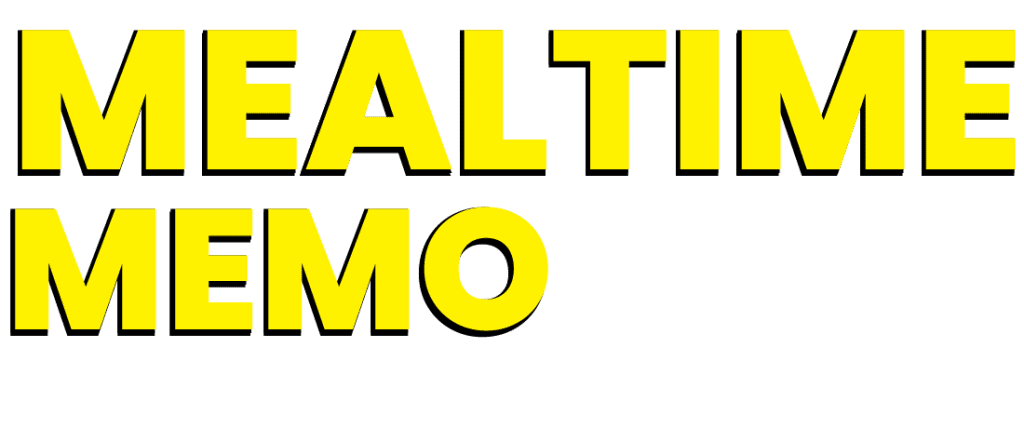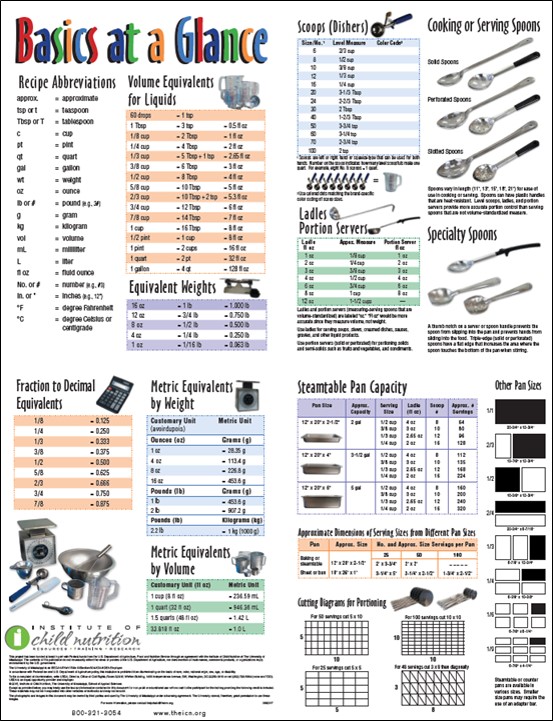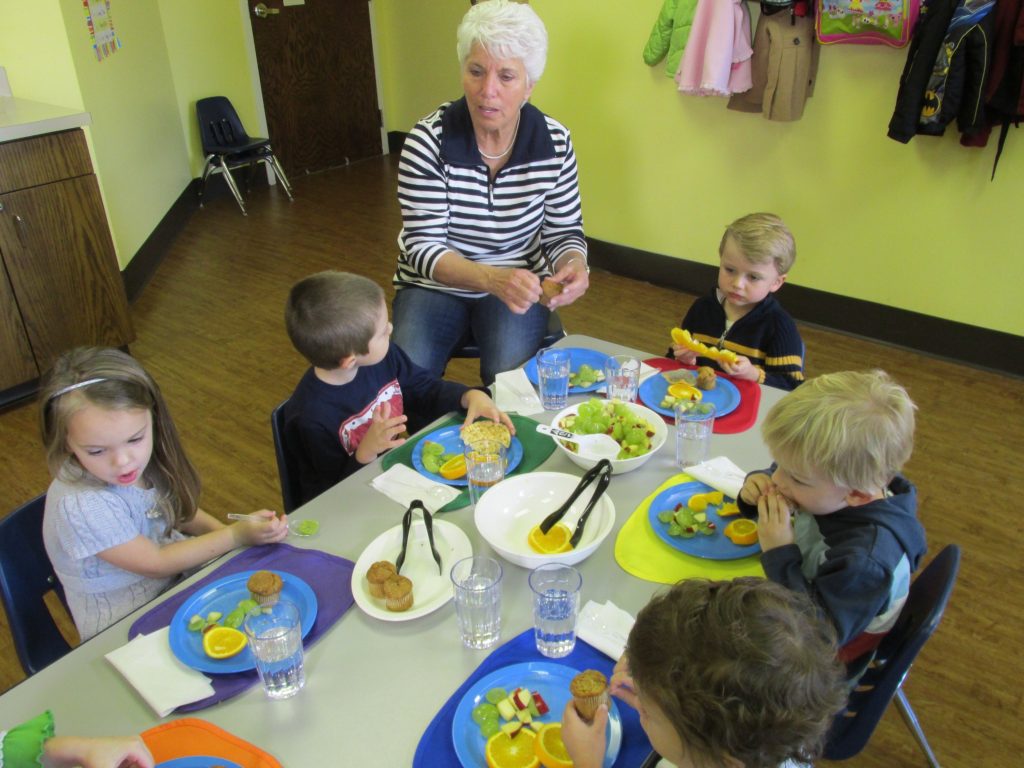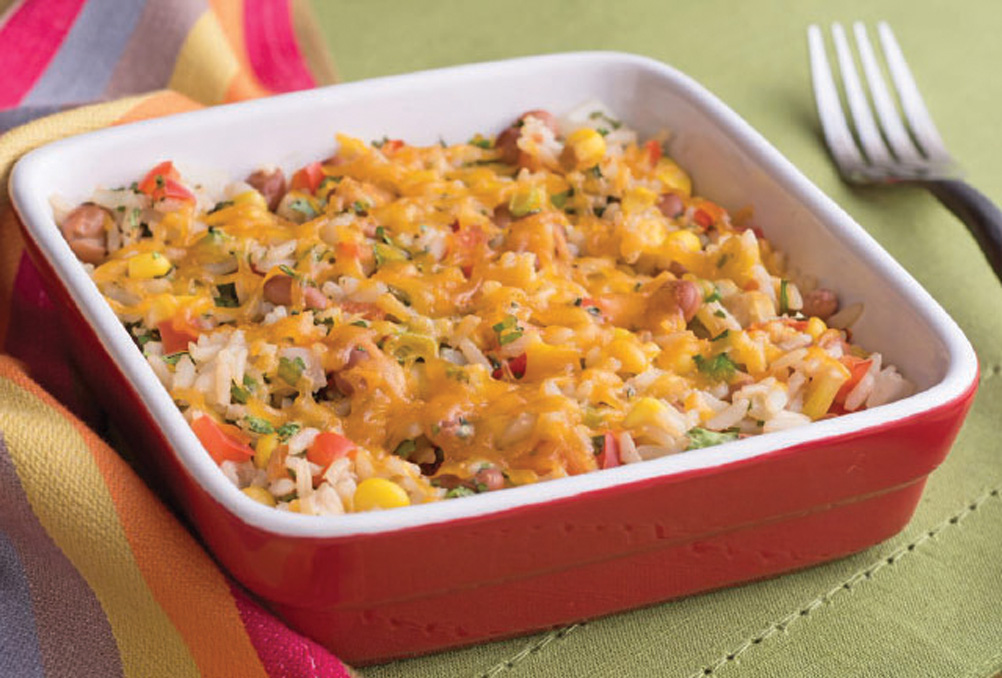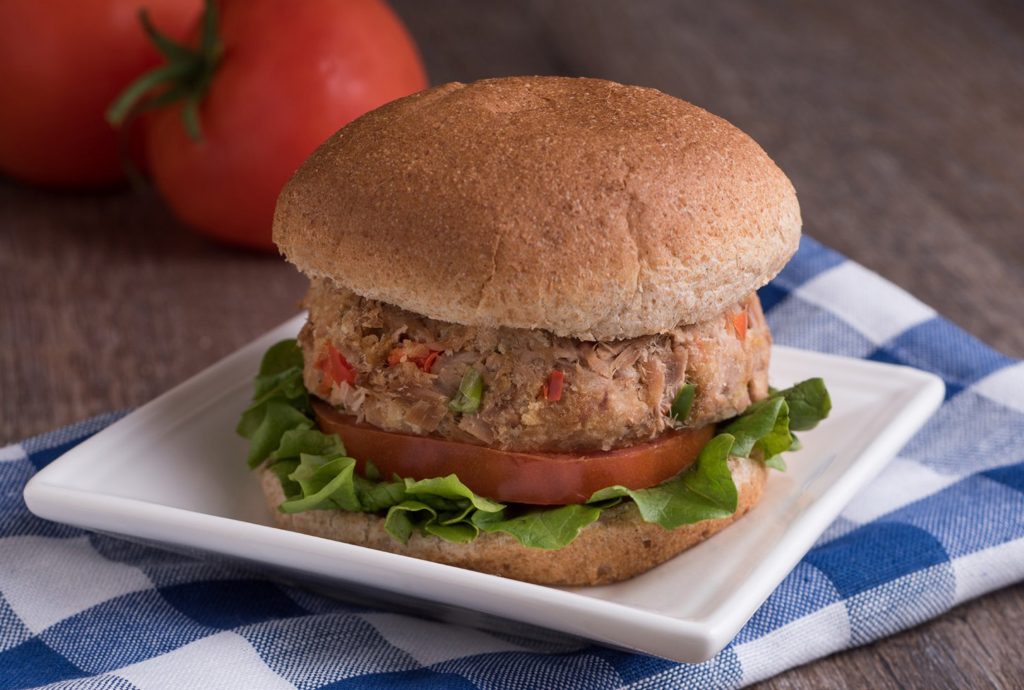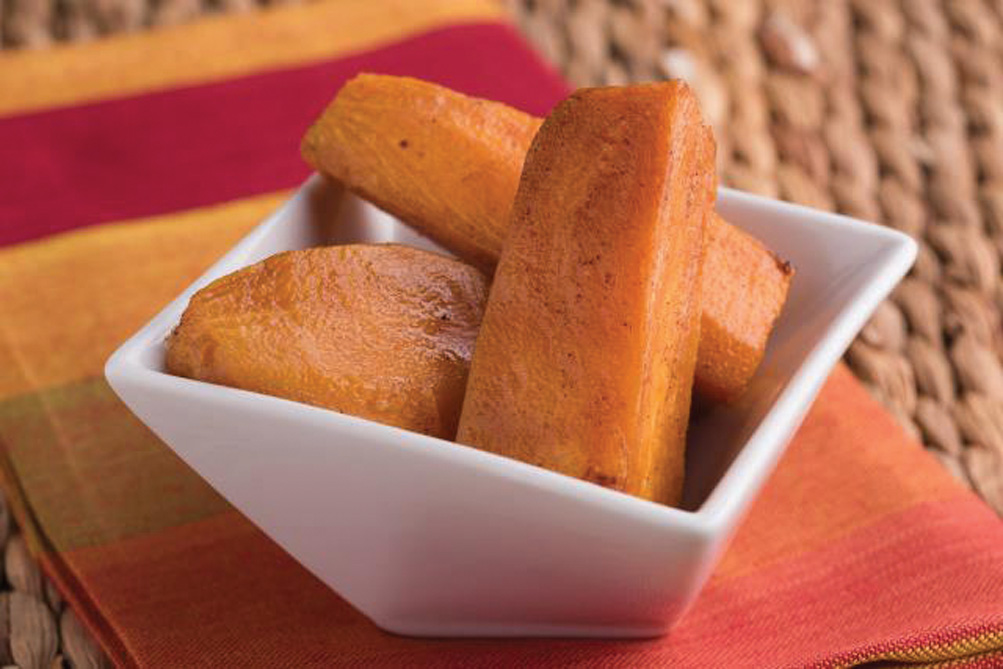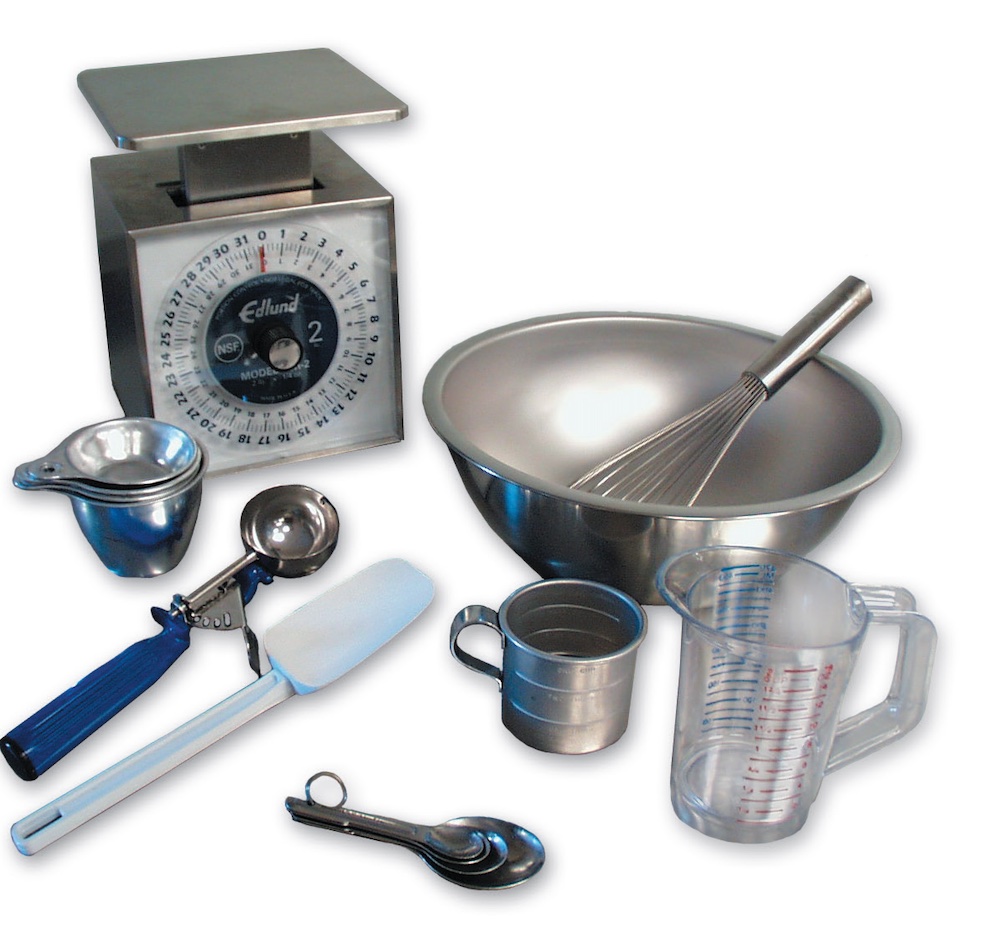
Which weighs more: a pound of lettuce or a pound of carrots? It’s a trick question! They weigh the same. However, if you think about how much space each would take up, a pound of lettuce would fill many more cups than a pound of carrots. Measuring can be confusing, so this Mealtime Memo will discuss the difference between weight and volume and describe tools to measure both most accurately.
Weight Versus Volume
Knowing the difference between weight and volume is important and allows you to measure ingredients accurately to ensure your recipe turns out correctly.
- Volume is the amount of space a substance occupies.
- Weight is the heaviness or mass of an item.
You also may have seen the terms “ounce” and “fluid ounce.” They may sound similar, but they do not mean the same thing. An ounce (oz) is a standard unit of weight, and a fluid ounce (fl oz) measures volume.
- Ounce (oz) = weight
- Fluid ounce (fl oz) = volume
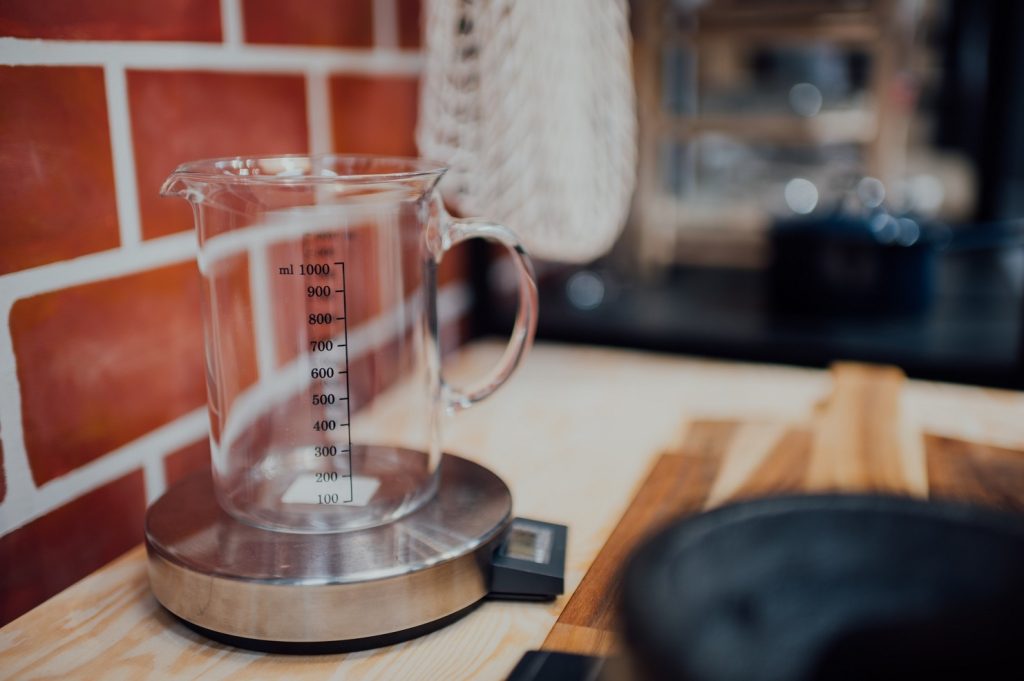
Let’s look at an example to show the difference between ounces and fluid ounces.
Water is a reference point because 8 fluid ounces (volume) equals 8 ounces (weight). If adequately measured in a volume measure, 1 cup of water weighs 8 ounces on the scale.
Liquids with a higher density than water, such as honey, weigh more. So one measured cup of honey weighs more than one cup of water.
- Water: 1 cup (8 fl oz) weighs 8 oz
- Honey: 1 cup (8 fl oz) weighs 12 oz
Some liquids, like canola or vegetable oils, are less dense than water and weigh less than one measured cup of water. If you have ever mixed oil and water, you likely noticed that the oil floats on top of the water and does not mix. The reasoning for this is that oil is slightly lighter than water.
Tools of the Trade
The tools to measure volume and weight are only accurate when you have the right tools and know how to use them correctly! Liquid measuring cups, dry measuring cups, and measuring spoons all measure volume. Use kitchen scales to weigh ingredients. Let’s look at examples of these tools.
Liquid Measure (Volume)
Use liquid measuring containers or cups when measuring liquids. Liquid measuring cups are usually glass or clear to see the liquid inside and ensure the measurement is correct.
Keep the following tips in mind when measuring liquid ingredients:
- Use the largest, appropriate standard measuring container.
- Place the liquid measuring container on a flat surface.
- Pour the liquid into the container until it reaches the desired level.
- Read at eye level when using a clear container. When using a metal container, look inside the container when filling the liquid to the desired level.
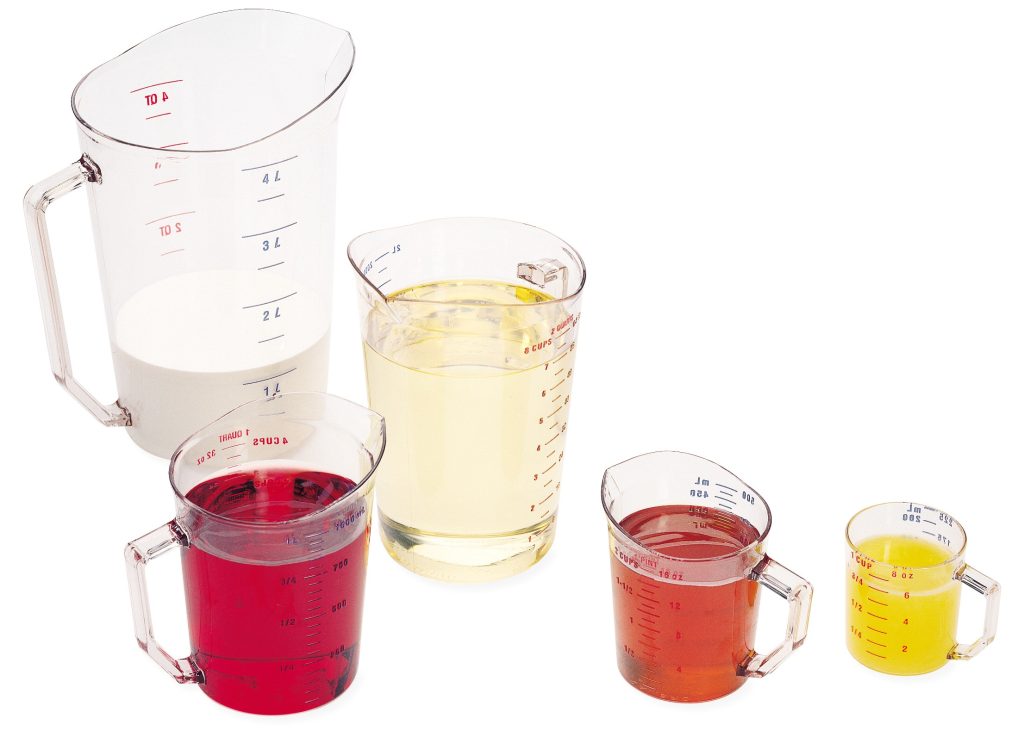
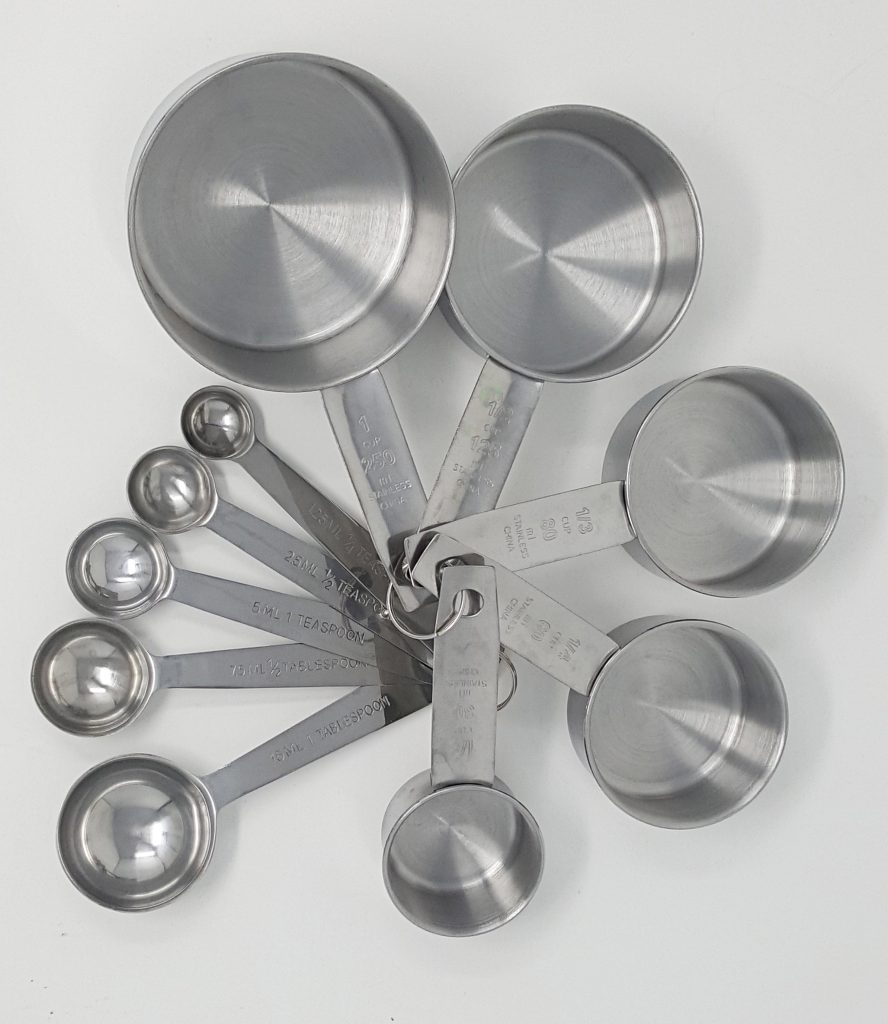
Dry Measure (Volume)
Use measuring spoons (teaspoon or tablespoon) to measure small amounts of ingredients (less than 2 fl oz), such as herbs and spices.
If a scale or weight of ingredients are unavailable, use dry measuring cups to measure dry and solid ingredients. Dry measuring cups are usually plastic or metal and come in different sizes, so you can fill them to the top for accurate measuring. Use the following tips to measure dry foods accurately.
- Use the largest, appropriate standard measuring container.
- Spoon the ingredient lightly into the measuring container.
- Exception: Pack brown sugar firmly into the measuring container so it will take the shape of the container when empty.
- Fill the measuring container overflowing; level off with a straight-edged spatula or knife.
- Avoid shaking or tapping the measuring container.
Measuring by Weight
Since weighing is a quicker, easier, and more accurate measurement method, use a kitchen or food scale to weigh larger amounts of dry ingredients and other solid ingredients. The most common food scales are traditional or electronic scales.
Make sure you know how to use the kitchen scale for accurate measurements.
- On the scale, select the unit of measurement (ounces or grams) listed in your recipe.
- If using a bowl or container to hold the food, press the “zero” or “tare” button after you place the container on the scale to avoid calculating its weight in the final amount.
- You can also place an empty bowl or container on the scale prior to turning it on, and it will tare to zero automatically.
Refer to the Culinary Institute of Child Nutrition (CICN) website for helpful videos and training on weights and measures.
Below is a chart summarizing the important terms and differences between volume and weight.
Traditional Scale
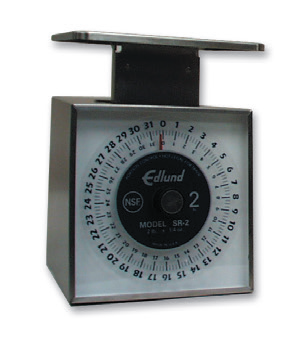
Electronic Scale
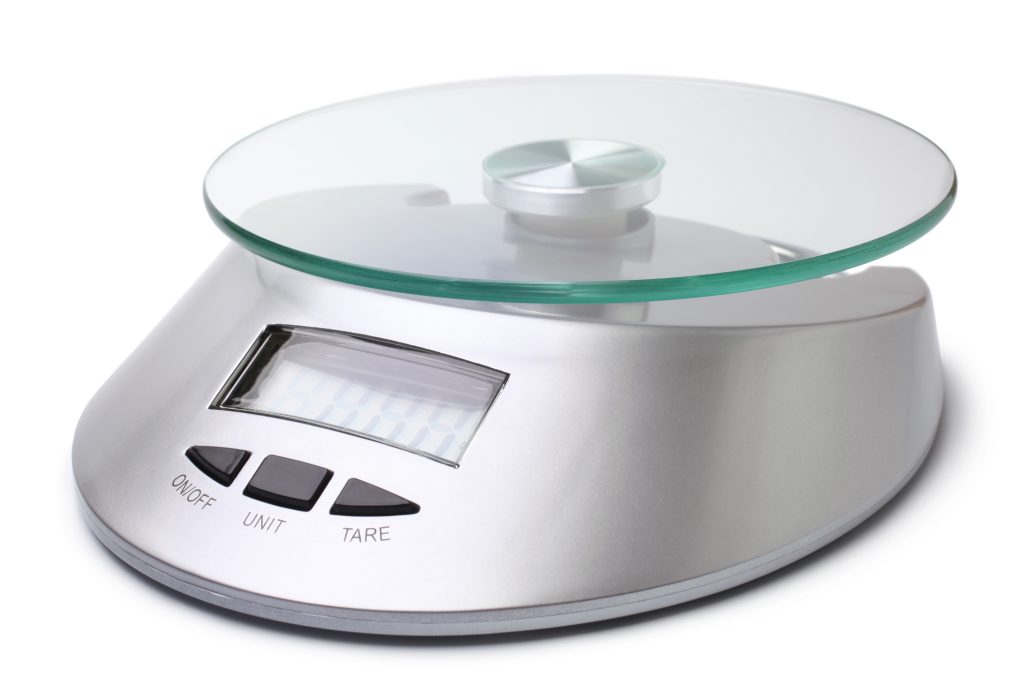
| Definition | Measuring Tools | Ingredients to Measure | |
|---|---|---|---|
| Volume |
Amount of space a substance occupies.
|
|
|
| Weight |
Heaviness or mass of an item.
|
|
|
Putting It All Together in the Kitchen
When working in the kitchen, consider the following tips to help navigate weight and volume.
- In recipes, ingredient amounts are listed in weight and volume (see below). Pay attention to the way they are listed, and use the proper tools to get the correct amount.
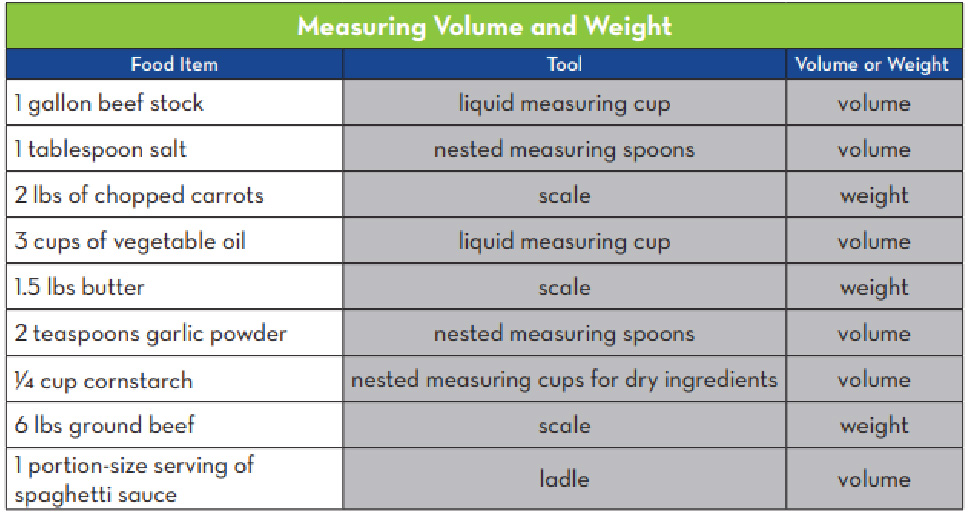
- Remember, weight-to-volume equivalents are different for every ingredient. For example, 1 cup of raw broccoli florets weighs ~3.25 ounces, but 1 cup of raw spinach weighs ~1 ounce. If you need to convert weight to volume or vice versa, use the Food Buying Guide for Child Nutrition Programs – Yield Tables to get this information.
- Finally, use tools that result in the least number of measurements possible. For example, if a recipe calls for 7 teaspoons of salt, you should measure 2 tablespoons and 1 teaspoon instead of measuring 7 teaspoons. Another measurement for this is 1/8 cup plus 1 teaspoon.
- The Basics at a Glance poster offers “at a glance” information on recipe abbreviations, measurement conversions, portioning tools, and fraction-to-decimal equivalents. Download and print the poster to include on your refrigerator. It is available in English and Spanish.
CACFP Meal Service
In the CACFP Meal Pattern, you will notice that some meal components are listed in volume, and some are listed in weight. Pay attention to what measurement is required.
- Fluid milk is listed in fluid ounces (volume). The 6 fluid-ounce serving for 3–5-year-olds is equal to ¾ cup.
- Meats are listed by weight (ounces), while some meat alternates are listed by volume (ex., ¼ cup cooked dried beans for a 1-2-year-old serving at lunch or supper).
- Grains are listed in ounce equivalents or by volume (ex., ¼ cup of pasta for a 3-5-year-old).
- Vegetables and fruits are listed in cups (volume).
To ensure children get the correct minimum requirements, follow these tips.
- Use the correct tools.
- Follow the instructions in the recipe. It will tell you the correct serving size (ex., ½ cup of broccoli) and may even tell you which tool to use.
- Portion out the correct amounts by leveling the food. If you do not fill an 8 oz ladle of soup, you are not serving the right amount of 8 fluid ounces.

Mealtime Discussion Prompts
Using measured serving spoons helps guide children to the correct serving size. Using the prompts below, help them think about how much they serve themselves.
- Have you ever helped cook at home?
- How do you know how much of an ingredient to add to what you are making?
- How do you know how much to serve yourself when you have a meal or snack?
Menu Ideas
The following menu ideas provide a variety of foods, colors, and textures. Some recipes contain multiple meal components listed in parentheses after the recipe.
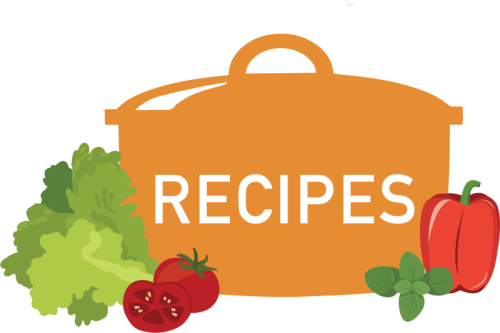
Recipes
- The Child Nutrition Recipe Box has USDA-standardized recipes for child care centers and family child care homes.
- The Child Nutrition Recipe Box: New CACFP Lunch/Supper Recipes has standardized recipes per age group (3–5 and 6–18 year-olds) and for servings of 6, 25, and 50.

References
Institute of Child Nutrition. (n.d.). Arroz con queso (rice with cheese) – USDA recipe for child care centers. Child Nutrition Recipe Box. https://theicn.org/cnrb/recipes-for-centers-grains-breads/arroz-con-queso-rice-with-cheese-usda-recipe-for-cacfp/
Institute of Child Nutrition. (n.d.). Asian tuna burger – USDA recipe for child care centers. Child Nutrition Recipe Box. https://theicn.org/cnrb/recipes-for-centers-sandwiches/asian-tuna-burger-usda-recipe-for-cacfp/
Institute of Child Nutrition. (n.d.). Basics at a glance. https://theicn.org/icn-resources-a-z/basics-at-a-glance/
Institute of Child Nutrition. (n.d.). Basic culinary math for school nutrition professionals. https://theicn.org/icn-resources-a-z/basic-culinary-math-for-school-nutrition-professionals/
Institute of Child Nutrition. (n.d.). Child nutrition recipe box. https://theicn.org/cnrb/
Institute of Child Nutrition. (n.d.). New CACFP lunch/supper recipes. Child Nutrition Recipe Box. https://theicn.org/cnrb/2022-cacfp-recipes/
Institute of Child Nutrition. (n.d.). Quick baked sweet potatoes – USDA recipe for child care centers. Child Nutrition Recipe Box. https://theicn.org/cnrb/recipes-for-centers-vegetables/quick-baked-sweet-potatoes-usda-recipe-for-cacfp/
Institute of Child Nutrition. (2019, June 28). Weights and measures. https://theicn.org/cicn/weights-and-measures/
Institute of Child Nutrition. (2022, July 7). Child and adult care food program child meal pattern. https://theicn.org/resources/1482/cacfp-meal-pattern-posters-and-infographics/116958/cacfp-child-meal-pattern-poster-2.pdf
U.S. Department of Agriculture, Food and Nutrition Service. (2022, July 11). Food buying guide for child nutrition programs. https://www.fns.usda.gov/tn/food-buying-guide-for-child-nutrition-programs


